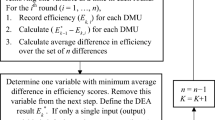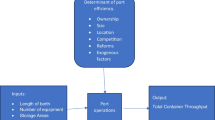Abstract
Despite the growing amount of research into container-port security regulations, no attempt has been made to-date to empirically investigate the ex-post impacts of security regulations on the operational efficiency of seaports and terminals. This article attempts to empirically assess and analyse the procedural impacts stemming from the requirements of port security regulations on the operational efficiency of container terminals. A stepwise Malmquist Data Envelopment Analysis approach is used to track productivity changes of 420 container-terminal decision-making units from 2002 till 2008, both on a multi-year basis and on a regulatory-run basis. The analysis of the impact of security on operational efficiency shows that the latter varies greatly by type of regulation and terminal, but there is a strong evidence of generalised productivity gains from targeted inspection prompted by cargo pre-screening and reporting and from the technological progress prompted by the investments in new security technology.



Similar content being viewed by others
References
Babione, R., Kim, C.K., Rhone, E. and Sanjaya, E. (2003) Post 9/11 Security Cost Impact on Port of Seattle Import/Export Container Traffic. The University of Washington Working paper GTTL 502.
Bell, M.G.H. and Bichou, K. (2008) Port efficiency and the stability of container liner schedules. Maritime Economics and Logistics 10 (1): 23–56.
Bennett, A.C. and Chin, Y.Z. (2008) 100% container scanning: Security policy implications for global supply chains. Master of Science Dissertation, MIT, pp. 1–174.
Bichou, K. (2004) The ISPS code and the cost of port compliance: An initial logistics and supply chain framework for port security assessment and management. Maritime Economics and Logistics 6 (4): 322–348.
Bichou, K. (2008) Maritime Security and Risk-Based Models: Review and Critical Analysis, Proceedings of the OECD/ITF Round Table on Security, Risk Perception and Cost-Benefit Analysis, Paris, France, pp. 1–31.
Bichou, K. and Evans, A. (2007) Maritime security and regulatory risk-based models: Review and critical analysis. In: K. Bichou, M.G.H. Bell and A. Evans (eds.) Risk Management in Port Operations, Logistics and Supply Chain Security, London, UK, pp. 265–280.
Booz Allen Hamilton. (2002) Port security war game, http://www.boozallen.com.
Bosk, L.B. (2006) Port and Supply-Chain Security Initiatives in the United States and Abroad. The University of Texas at Austin Policy Research Report 150, pp. 1–192.
Damas, P. (2003) Supply chains at war. American Shipper, November 2001, pp. 17–18.
Dekker, S. and Stevens, H. (2007) Maritime security in the European Union – Empirical findings on financial implications for port facilities. Maritime Policy and Management 34 (5): 485–499.
DNV Consulting. (2005) Study on the Impacts of Possible European Legislation to Improve Transport Security. European Commission Report 40008032-6-2, pp. 1–236.
Donner, M. and Kruk, C. (2009) Supply chain security guide. The World Bank/DFID 1 : 1–107.
Färe, R.S. and Lovell, C.A.K. (1994) Production Frontiers. Cambridge: Cambridge University Press.
Gordon, P., Moore, J.E., Richardson, H. and Pan, Q. (2005) The Economic Impact of a Terrorist Attack on the Twin Ports of Los Angeles-Long Beach. Center for Risk and Economic Analysis of Terrorism Events: report facility Draft 05-012, University of Southern California.
Hercules, R. (2006) Cargo Security Strategy in the Post 9/11 Era. Proceedings of the International Forum of the Writing Instrument Manufacturers Association, San Francisco, Washington DC, USA, pp. 1–45.
International Monetary Fund (IMF). (2001) World Economic outlook: The global economy after September 11, http://www.imf.org/external/pubs/ft/weo/2001/03.
Kruk, B. and Donner, M. (2008) Review of cost of compliance with the new international freight transport security requirements. World Bank Transport Papers 16: 1–58.
Lee, H.L. and Whang, S. (2005) Higher supply chain security with lower cost: Lessons from total quality management. International Journal of Production Economics 96 (3): 289–300.
Mann, H.B. and Whitney, D.R. (1947) On a test of whether one of two random variables is stochastically larger than the other. Annals of Mathematical Statistics 18: 50–60.
Mc Calla, J. (2008) Container transhipment at Kingston: Jamaica. Journal of Transport Geography 16 (3): 182–190.
NISAC. (2005) Port Operations and Economic Conditions Simulators. Washington DC, USA: NISAC, pp. 1–15.
Organisation for Economic Cooperation and Development. (2003) Security in maritime transport: Risk factors and economic impact. OECD 1 : 1–59.
Park, J., Gordon, P., Moore, J.E., Richardson, H.W. and Wang, L. (2007) Simulating the state-by-state effects of terrorist attacks on three major U.S. ports: Applying NIEMO (National Interstate Economic Model). In: H.W. Richardson, P. Gordon and J.E. Moore (eds.) The Economic Consequences of Terrorism. Cheltenham, UK: Edward Elgar, pp. 208–234.
Rabadi, G., Pinto, C.A., Talley, W. and Arnaout, J.P. (2007) Port recovery from security incidents: A simulation approach. In: K. Bichou, M.G.H. Bell and A. Evans (eds.) Risk Management in Port Operations, Logistics and Supply Chain Security. London, UK: Informa, pp. 83–94.
Rosoff, H. and Von Winterfeldt, D. (2005) A Risk and Economic Analysis of Dirty Bomb Attacks on the Ports of Los Angeles and Long Beach. Center for Risk and Economic Analysis of Terrorism Events: report facility Draft 05-02, University of Southern California.
Talas, R. and Menachof, D. (2009) The efficient trade off between security and cost for seaports: A conceptual model. International Journal of Risk Assessment and Management 13 (1): 46–59.
US Department for Homeland Security. (2003) N-RAT Assessment Exercise Part II: Implementation of National Maritime Security Initiatives. The Federal Register: 68/204.
United Nations Conference on Trade and Development. (2007) Maritime Security: ISPS Implementation, Costs and Related Financing. Geneva, Switzerland: UNCTAD, pp. 1–51.
Author information
Authors and Affiliations
Appendix
Rights and permissions
About this article
Cite this article
Bichou, K. Assessing the impact of procedural security on container port efficiency. Marit Econ Logist 13, 1–28 (2011). https://doi.org/10.1057/mel.2010.16
Published:
Issue Date:
DOI: https://doi.org/10.1057/mel.2010.16




